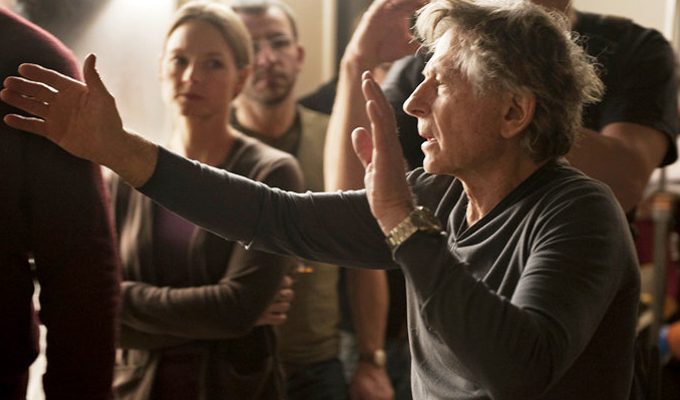
“Cul-de-Sac” (1966)
Throughout Polanski’s career he has frequently returned to the trope of carefully-constructed power struggles that overheat in confined spaces, often centering these dramas on two males and one female (see “Death & The Maiden,” “Knife In The Water,” or even “Carnage” that adds a fourth person into its one-setting scenario). So it’s no real surprise that only one feature after having the action of ‘Knife’ play out on a boat, he immediately revisited the theme in “Cul-de-Sac” — recently brought back to DVD by the Criterion Collection. Set in a castle on a remote island in North East England, “Cul-de Sac” initially focuses on a wounded criminal, Dickie (Bronx-born tough-guy actor Lionel Stander) and his dying partner who take refuge at a beachfront castle owned by a ineffectual Englishman (Donald Pleasance) and his gorgeous and headstrong French wife (Françoise Dorléac). The duo take the pair hostage, but soon Dickie’s partner dies from his gun wounds and the mobster is forced to wait for never-arriving back-up while he bickers and squabbles with both the husband and the wife. And while a strangely humorous relationship dynamic begins to emerge among the trio, snotty guests continue to drop by unannounced, and keeping the ruse going becomes even trickier. Nihilistic and filled with unlikable characters, “Cul-de-Sac” is often compared to Samuel Beckett‘s “Waiting For Godot” and the works of Harold Pinter, but it also plays with some of the director’s favorite themes like emasculation, insanity, isolation and sexual frustration. Maybe not Polanski’s best — which is why it took years to get a proper DVD release — but as a wry little tragicomedy, it’s a diverting and entertaining effort. [B]
 “The Fearless Vampire Killers” (1967)
“The Fearless Vampire Killers” (1967)
If monomaniacal modern vampire culture is getting you down, maybe it’s time to revisit the earlier cape-wearing incarnations of the myth, before vamps got all sparkly and in touch with their feelings. Or, on this evidence, maybe not. Polanski’s campy parody is these days most notable as the film on which he met his future wife Sharon Tate (shot here to be not so much beautiful as bioluminescent), and while it’s silly and fleetingly amusing it’s not really mandatory viewing for the genre, or for Polanski’s oeuvre either, for that matter. At a stretch, if we want to fit it into the wider “story” of Polanski’s career, we can look at it as marking one of the few times he left his style of usual comedy often so dark, so understated, to go broad (depending on what you think of “What?” and “Pirates”). But here again it’s difficult to judge exactly, as the film was famously recut for U.S. audiences to be more of a cartoony spoof than was possibly intended. Widely recognized as one of his weakest heyday-era films, it does still have some curiosity value, however, especially to see the impish director himself clowning around goofily amid the kids-at-Halloween-style Dracs. And special mention must be given too to the eerie, choral-vocal-led score by Krzysztof Komeda, which alone is worth the price of admission. A vampire movie in which the soundtrack is the most interesting thing? Maybe it’s not so different from “Twilight” after all. [C-]
 “Rosemary’s Baby” (1968)
“Rosemary’s Baby” (1968)
The second part of the unofficial “apartment trilogy” (which began with “Repulsion” and concluded with “The Tenant“) and the most important film of that bunch, “Rosemary’s Baby” was an Oscar-winning American horror film that took on even more haunting dimensions after Polanski’s life was struck by tragedy. The story, based on a successful novel by Ira Levin, was optioned by William Castle, the cigar-chomping showman mostly known for his in-theater gimmicks (rather than his largely subpar films). When he brought the film to Paramount, they agreed to bankroll it on one condition – Castle himself could not direct it. Begrudgingly, he handed the reins over to Polanski (Castle still makes a split-second cameo in the film, as a man Rosemary takes for her villainous doctor). The result was an all-time horror classic. Rosemary (Mia Farrow) is a woman happily married to an actor (John Cassavettes) and the proud owner of a cavernous New York City apartment. After she becomes pregnant, those benign elements of her life start to take on a freakish, otherworldly dimension, as she becomes convinced that the baby inside her is a creature of supernatural importance. Farrow, in a role that would divide her from then-husband Frank Sinatra and cause a pixie-bob haircut sensation, is dynamite and Polanski’s arty background serves the film well, obscuring outright horror and letting us sympathize with our leading lady. Without any context it’s already a masterpiece of dread and paranoiac unease, but Polanski’s intimate connection, just the following, year to a real-life horror story retrospectively lends the proceedings an added layer of uncanny eeriness. [A]

